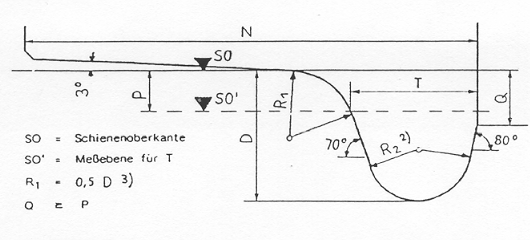Track and wheel standards in N scale
Please notice that MOROP's NEM norms and NMRA's standards are revised from time to time. Because of this the content in this article may be imprecise, please only use the current version of the NEM norms and the NMRA standards.
NEM norms (Normen Europäischer Modellbahnen) and NMRA standards (National Model Railroad Association) are the two system standards used in Denmark.
NEM is used as a matter of course as Denmark through DMJU (Dansk Model Jernbane Union) is a member of MOROP who makes and maintains NEM.
NMRA standards are used partly because many model railway people during the years has not been satisfied with NEM (for instance on flange size), and partly because some model railway people are running American-prototype trains and/or are buying equipment and parts from America.
1. Track

| Norm/standard | Gmin Gmax |
Cmin - |
- Smax |
- Fmax |
Hmin - |
- Pmax |
| NEM 310, NEM 124 | 9.0 9.3 |
8.1 - |
- 7.3 |
- 1.0 |
0.9 - |
- 7.8 |
| NMRA S-3.2 | 8.97 9.32 |
8.20 - |
- 7.52 |
- 0.76 |
0.56 - |
- 7.92/8.05 *) |
*) Electr./mech. All measurements in mm.
As the table shows there are some small differences between NEM and NMRA, namely Cmin and Smax. They don't seem significant but as will be seen later they may give problems if you mix the NEM and NMRA standards.
2. Wheels

| Norm/standard | - Kmax |
Bmin - |
Nmin - |
Tmin Tmax |
- Dmax |
P - |
| NEM 310, NEM 311 | - 8.1 |
7.4 - |
2.2 - |
0.5 0.6 |
- 0.9 |
0.15 - |
| NMRA S-4.2, RP25 | - 8.20 |
7.54 - |
1.80 - |
- 0.51 |
- 0.56 **) |
0.18 - |
**) RP25 = 0,51. All measurements in mm.
Here there are small differences between NEM and NMRA, too, primarily on Kmax, Bmin and Nmin. Furthermore the flange height D may be 0.9 mm to NEM but only 0.56 mm to NMRA.
3. Wheel profile

| Norm/standard | Nmin | Tmin | Tmax | Dmax | P |
| NEM 311 | 2.2 | 0.5 | 0.6 | 0.9 | 0.15 |
All measurements in mm.

| Norm/standard | N' | T | W | D' | P | R1 | R2 | R3 |
| NMRA RP25 | 1.83 | 0.51 | 1.32 | 0.51 | 0.18 | 0.20 | 0.23 | 0.23 |
All measurements in mm.
The differencies in section 2 are also seen here. As can be seen, the wheel profiles are a little different.
4. Flange height
Small flanges and narrow wheels look nicer, I feel. As early as around 1972 I experimented turning down flanges on metal wheels in N scale, for instance Minitrix wheels, and on a Piko MY diesel locomotive. I had no problems keeping equipment on the track.
Micro-Trains makes wheel sets with very high flanges (0.9 mm), so-called "pizza-cutter" flanges, and low flanges (0.5 mm), so-called "low-profile" wheel sets. Many model railway people in the USA have switched to using low flanges, and many tell that they have fewer derailments using Micro-Trains low-profile wheels than using high flanges.
5. NMRA wheel sets on NEM track
The wheel sets can run through turnouts but there are two disadvantages
- Kmax of the wheel set (8.20 mm) is larger than Cmin of the turnout (8.1 mm) so there is a risk that one wheel may strike the crossing nose
- Nmin of the wheels (1.80 mm) is less than 2*F (Fmax = 1.0 mm) in the turnout, hence the wheel will fall down between the wing rails ahead of the crossing nose
6. NEM wheel sets on NMRA track
The wheel sets may not run through turnouts because
- Bmin of the wheel set (7.4 mm) is less than Smax of the turnout (7.52 mm) so that the wheel may bind on guard and wing rails.
7. Conclusion
You can use 0.5 mm flange height without any problems. From USA there are quite a number of wheel sets with low flanges to be had, while on European equipment you will normally have to turn down the flanges yourself.
When you choose system standards you ought to choose either NEM or NMRA for both track and wheels alike as NEM and NMRA are not fully compatible.
You should be aware that some of the equipment that can be bought ready-to-run does not comply to the NEM or NMRA standards. You will have to check yourself if you want to avoid derailments.
8. Links
- MOROP - Verband der Modelleisenbahner und Eisenbahnfreunde Europas
- MOROP - Die Normen - table of content and links
- NEM 124 (pdf)
- NEM 310 (pdf)
- NEM 311 (pdf)
- NMRA - NATIONAL MODEL RAILROAD ASSOCIATION
- NMRA Standards and Recommended Practices
- NMRA S-3.2 (pdf)
- NMRA S-4.2 (pdf)
- NMRA RP25 (pdf)